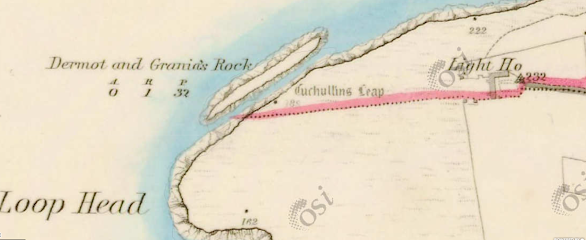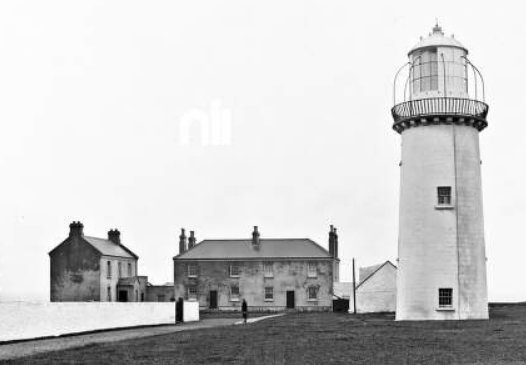Loop Head - the early years
Loop Head today (By Charles W Glynn, CC BY-SA 2.0, https://commons.wikimedia.org/w/index.php?curid=1909644)
'In far Loop Head did somebody a stately small lighthouse erect ...'
So begins the first draft of Samuel Taylor Coleridge's epic poem "Kubla Khan," which sadly veered off the subject of pharology in later versions. It was a shame that Sammy didn't mention when the lighthouse was built and by whom, as it would have avoided a lot of confusion among today's lighthouse historians.
At the tip of the Loop or Leam peninsula, there is a wonderfully photogenic rock lying parallel to the cliff face. Legend has it that Cu Culainn, pursued by an old woman, leapt from the mainland onto the rock. The woman followed. Summoning all his strength, The Hound leapt back and the old woman, trying to do the same, fell to her death. (I'm sure I saw this in a film on the New York subway) Hence the name Cuchullins Leap. OSI First edition map
Who built the first lighthouse? Well, there is apparently little disagreement on this subject because nobody seems to know and, if they do, they're not saying.
As most lighthousey people are aware, a patent was granted to Sir Robert Reading in the mid-1660s to construct and maintain six lighthouses around the coast - two at Kinsale, two at Howth, one at Hook (re-established) and one at Islandmagee. There were others in existence too, at Carrickfergus and Donaghadee, probably built by local benevolence or merchants. It is probable that the Loop Head light was established by either the merchants of Limerick or the local big landowner or both to light the way into the Shannon estuary.
When was it built? Well, Bill Long says 'around 1670.' Richard M. Taylor shies away from a date. Dick Robinson in the North Munster Antiquarian Journal plumps for 1670. I have seen 1690 mentioned and 1715 too, the former being the date it allegedly appears on an ancient map, which I have not been able to locate.
Merchants of Limerick petitioned the Irish parliament in 1717 to re-establish this lighthouse, which had fallen into darkness and disrepair for the past twenty years (giving an original date of prior to 1697) It is unclear whether the new lighthouse, established in 1720 was a new lighthouse or a fixer-upper job.
The lighthouse was an old cottage-style lighthouse similar in style to those at the Old Head of Kinsale, the Green Bayly at Howth and Muldersleigh Hill on Islandmagee. Most accounts agree it consisted of two or three rooms, in between two of which there was a staircase leading up to a brazier on the roof, from which a fire burned brightly. Like the other three cottage-type lights at the time, the building had a vaulted roof - unique to Ireland - reminiscent of the oratories and monks' cells in the south-west of Ireland.
Sketch of the original cottage lighthouse by Michael Costello, former CIL man, whose research into Irish lighthouse history has formed the basis of many a book. Curiously he depicts Loop Head as roughly half the size of the Baily, Old Head of Kinsale and the Copeland Islands cottage light
Section of the vaulted ceiling that apparently can still be seen today. John Sloane, writing in the 1880s, says the old cottage was being used as a coal house (photograph by Jim Ryan in the Clare Champion)
Patricia Lysaght, writing in Béaloideas in 2007, quotes Liam Ó Foghlú (born in 1850) in relation to the cottage lighthouse:
The obvious problem here is the timeline. Nobody that Liam knew would have been alive in 1720, but maybe it is a folk memory, handed down, with, as Ms Lysaght remarks, the visual presence of the old lighthouse keeping the story alive.
It is unclear whether Polly was the first keeper of the 1670 or the 1720 light but the surname is well-known in lighthouse circles down through the generations, right to the very end. He certainly wasn't short of a fire to put the kettle on. Another source says it was a man from Donegal who lit the first Loop Head light. Michael Moore, a lightkeeper in the first half of the 20th Century claimed descendance from a man named Duplex who used to have to light the fire on top of the house at Loop Head.
Another Loop Head keeper appears to have been Mrs. Mary Westby, whom George III appointed 'Keeper of the lighthouse at Loop Head ... and also lighter of the fire.' One might be tempted to ask what the difference was between the two titles and what on earth was George III's interest in this, but as he was the mad one (I think) the answer to both questions might be the same. Mary held this position in 1771.
The cottage lighthouse with live-in keeper and family survived until 1802 when Thomas Rogers, Chief Lighthouse Builder of the Revenue Commissioners, built a 23 meter tall tower containing a lantern lit by 12 oil lamps. This in turn was replaced in 1854 by a tower of similar size nearby, the current light. Obviously with the two towers being of a similar height, the 1802 tower had to be truncated. There is no sign of this tower nowadays but the curious structure, below, photographed in the early 1900s, looks like it might well have been the base of the older tower.
Though, as my wife will happily tell you, I am frequently wrong about a lot of things.
Above and below, the current light in 1905, from the CIL collection in the National Library










Comments
Post a Comment